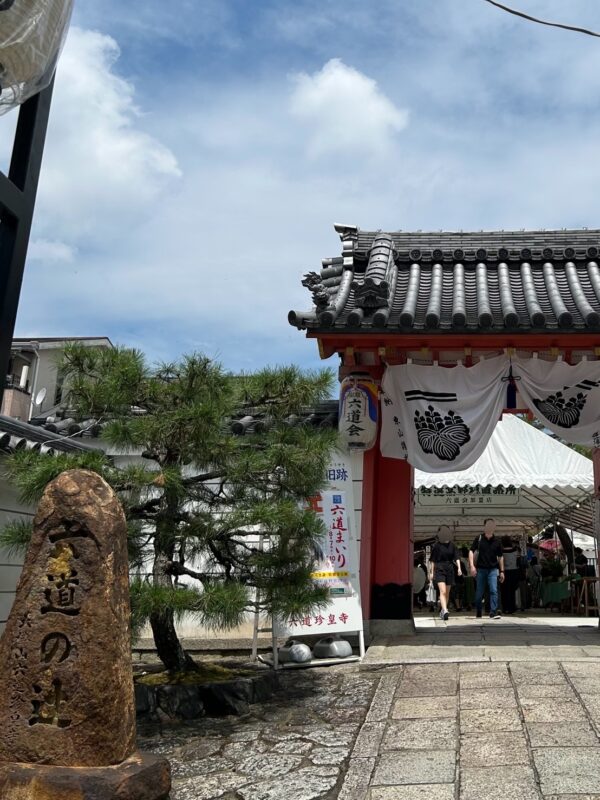
2025.08.09

ほとりから徒歩10分程の清水五条エリアでは、お盆の時期の楽しみなイベントがあります。
五条若宮陶器祭です。8月7日から10日までの4日間開催されます。もともと清水焼で有名なエリアですが、この期間はお店では見かけない陶芸作家さん、若手作家さんの作品を沢山見る事ができます。
昔は陶器市と呼ばれていましたが、コロナ期に一旦途絶え、3年前から五条若宮陶器祭として復活しました。80近くあるテントエリアのお店は勿論ですが、店舗を構えておられる陶器屋さんやギャラリーでもこのタイミングでは入りやすくも掘り出し物を見つけるのが楽しみです。



私は銀化鉄釉のお洒落なお皿を購入しました。角度によってはステンレスの様な光沢に見えます。これにケーキを載せようかな、アクセサリートレイにしようかなと色々想像するとワクワクします。作家さんと交流してお話するのも陶器祭の楽しみの一つです。
以前美人祈願でご紹介した若宮八幡宮には陶器の神様が祀られているので、「陶器神社」として知られるようになり、「陶器まつり」へと発展しました。境内には屋台もあり、御神輿も準備されており参拝するだけで「おまつり」気分が盛り上がります。
陶器祭の成功と陶器で生活が豊かになる事を祈願しました。



その後は、六道珍皇寺へ。
このお寺はいわゆるこの世とあの世の境の辻が、寺の境内あたりであるといわれ、冥界への入口とも信じられてきました。そして、こちらも陶器祭と同じ期間の8月7日から10日まで『六道まいり』が開催されています。盂蘭盆でご先祖様を迎えるためのおまいりで『精霊迎え』とも呼ばれているそうです。
明るい鮮やかな緑色の高野槙を買い求め、水塔婆に故人の戒名を書いてもらい、迎え鐘を突き、水塔婆を線香で清め、所定の場所に納めるとい一連の流れがあり、沢山の参詣者がご先祖様を迎える準備をされていました。
迎え鐘を突く為に、長い長い行列ができていました。仏教でもそれぞれの宗派や地域で盂蘭盆のお作法がありますが、お墓参りだけでなくこういった先祖供養の仕方があるんだなと新しい発見をしました。
六道まいりでご先祖をお迎えし、八月十六日の大文字の送り火でまたあちらの世界へ送り出すという、いかにも京都らしいお盆スタイルだなと感じたのでした。



There is an exciting event in the Kiyomizu Gojo area, about a 10-minute walk from Hotori, during the Obon season.
It is the Gojo Wakamiya Pottery Festival. The festival lasts four days, from August 7th to 10th. The area is famous for Kiyomizu Pottery, and during this period, we can see works by ceramic and young artists that are not usually found in stores.
It used to be called the Pottery Market, but it was temporarily discontinued during the pandemic and revived three years ago as the Gojo Wakamiya Pottery Festival. There are nearly 80 shops in the tent area, and it’s also fun to visit the pottery shops and galleries with permanent stores at this time of year because they’re easy to access, and you can find great bargains.
I bought a stylish plate with a silver glaze. Depending on the angle, it has a lustrous finish reminiscent of stainless steel. I’m excited to use it as a cake plate or an accessory tray. Another highlight of the pottery festival is interacting with and chatting with the artists.
As I mentioned before, Wakamiya Hachimangu Shrine is a popular place to pray for beauty. It is also known as the “Pottery Shrine” because it enshrines the god of pottery. This has led to the development of the “Pottery Festival.” Food stalls are set up on the shrine grounds, and a portable shrine is prepared, so just visiting the shrine puts you in a festive mood. I prayed for the success of this Pottery Festival and for pottery to enrich our lives.


Next, I went to Rokudouchinou-ji Temple.
This temple is said to be located at the crossroads between this world and the other world and is believed to be the entrance to the other world. The Rokudo Mairi festival is held here from August 7th to 10th, during the same period as the pottery festival. During this time, people welcome the spirits of their ancestors, so it is called “Spirit Welcoming.”
A series of rituals are performed, including buying juniper leaves, writing the names of the deceased on a wooden plate, ringing the welcome bell, purifying the plate with incense, and placing it in the designated spot. Many worshippers are preparing to welcome their ancestors.
A long line of people waited to strike the welcoming bell. Although each sect and region of Buddhism has its own Obon customs, I discovered that there are other ways to honor one’s ancestors besides visiting their graves.
I felt this Obon style is very Kyoto-esque, with the Rokudou Mairi welcoming ancestors and the Daimonji bonfire sending them back to the other world on August 16.
Mikko

